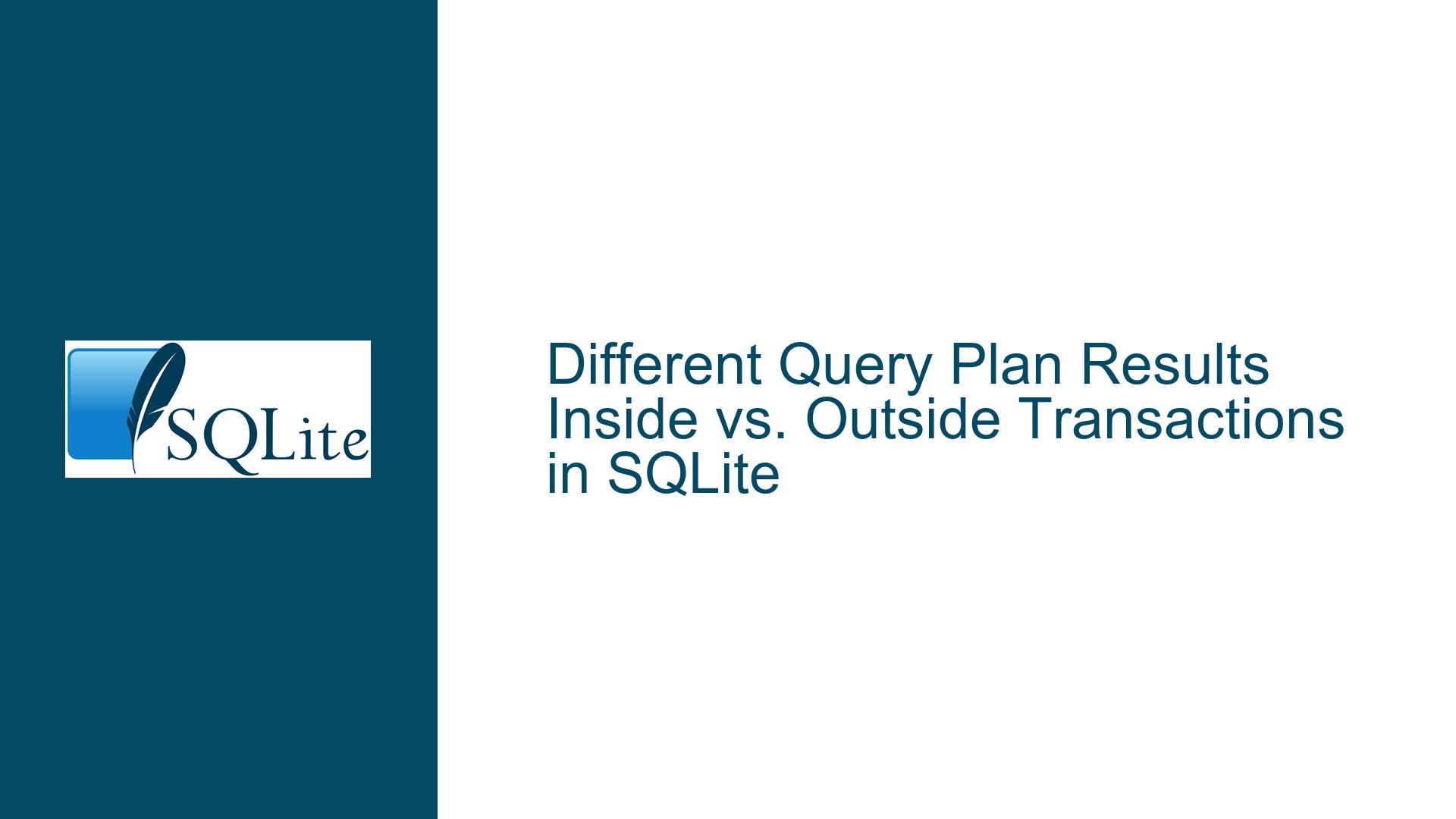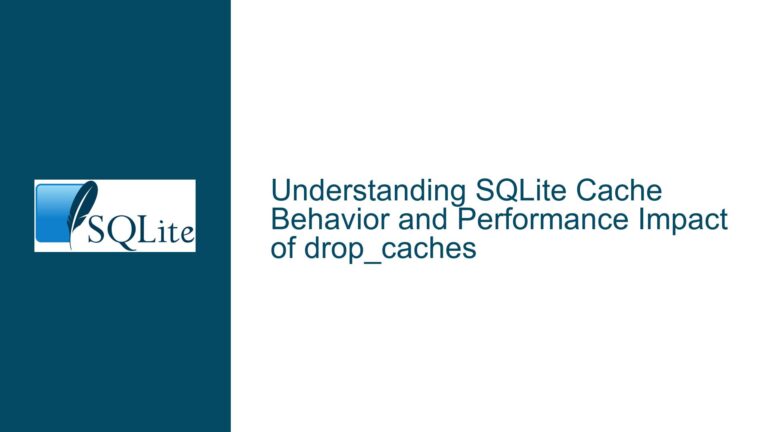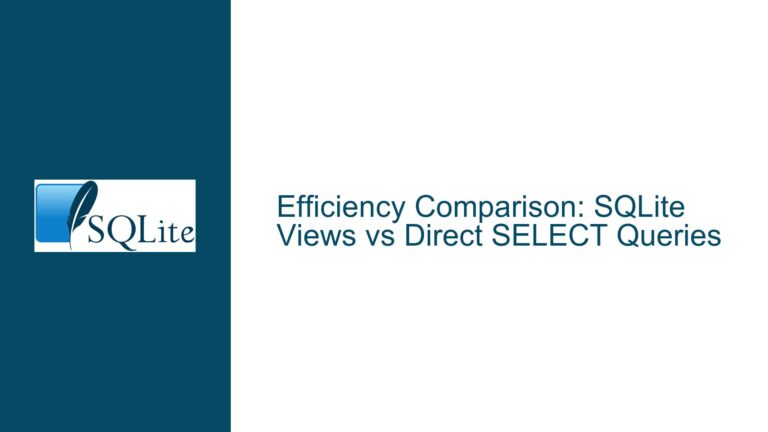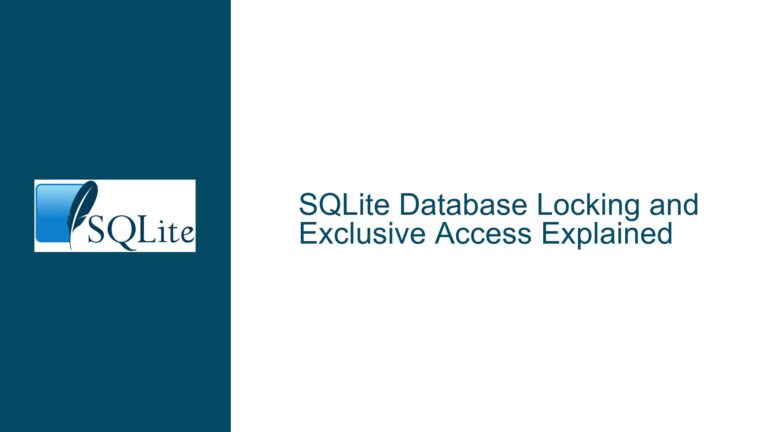Different Query Plan Results Inside vs. Outside Transactions in SQLite
Schema Configuration, Transaction Context, and Query Plan Stability
Database State and Query Plan Discrepancies in Transactional Contexts
Issue Overview
The core challenge arises when executing EXPLAIN QUERY PLAN (EQP) on the same SQL statement yields different results depending on whether the query is executed inside or outside an explicit transaction. Specifically, a query that correctly utilizes an index outside a transaction may resort to a full table scan when executed within a transaction. This discrepancy can lead to unexpected performance degradation, especially in automated testing environments where query plan validation is part of the workflow. The issue is counterintuitive because SQLite’s query planner is designed to generate execution plans based on schema definitions, index statistics (stored in sqlite_stat1, sqlite_stat4), and database contents—factors that should remain consistent within a single database connection unless explicitly modified.
The problem is not rooted in a fundamental flaw in SQLite’s transaction management but rather in subtle interactions between transactional context, schema metadata visibility, and the query planner’s assumptions. For instance, transactions that modify the database schema or data before executing the query in question can alter the optimizer’s calculations. Additionally, deferred transaction initialization, temporary schema objects, or outdated statistics can contribute to differing query plans. The behavior may also surface when the database connection has uncommitted changes that affect the planner’s cost estimations, even if those changes are unrelated to the queried tables.
Transactional Isolation, Schema Visibility, and Statistical Anomalies
Possible Causes
Outdated or Missing Index Statistics:
SQLite relies onsqlite_stat1andsqlite_stat4tables to estimate the selectivity of indexes. If these statistics are missing, incomplete, or generated under a different data distribution (e.g., empty tables during testing), the query planner may misestimate the cost of index scans versus full table scans. Within a transaction, especially one that has modified data but not yet committed, the planner may temporarily lack access to up-to-date statistics, leading to suboptimal plans. For example, if a transaction inserts a large volume of data into a table but does not update the statistics, the planner might assume a smaller table size, favoring a full scan over an index lookup.Deferred Transaction Locking and Schema Snapshotting:
SQLite employs a deferred transaction model by default, where locks are acquired incrementally. When a transaction begins withBEGIN DEFERRED, the database schema and statistics are snapshotted at the first read operation. If the transaction includes schema changes or data modifications before executing the query, the planner may operate on a stale schema or statistical snapshot. Conversely, outside a transaction, the planner always uses the latest committed schema and statistics. This can lead to divergent query plans if the transaction’s initial operations alter the database state before the problematic query is run.Temporary Schema Objects or Connection-Specific State:
Queries executed within a transaction may reference temporary tables, views, or indexes that are not visible outside the transaction. If the query plan validation tool does not account for temporary schema objects, it might incorrectly assume a full table scan is occurring when the query is actually using a temporary index. Similarly, connection-specific settings likePRAGMA case_sensitive_likeorPRAGMA temp_storecan influence the planner’s decisions but may not persist across transactional boundaries.Query Plan Stability Guarantee (QPSG) Interactions:
Enabling the Query Plan Stability Guarantee (SQLITE_ENABLE_QPSGcompile-time option) forces SQLite to generate identical query plans for the same SQL text, regardless of changes to database statistics. If QPSG is enabled, the query plan should remain consistent inside and outside transactions. However, if QPSG is disabled (the default), the planner may re-evaluate index costs based on real-time statistics, leading to plan variations. Testing with QPSG enabled can help isolate whether statistical fluctuations are the root cause.Uncommitted Changes and Visibility Rules:
SQLite’s isolation model ensures that uncommitted changes in a transaction are visible to subsequent queries within the same connection. If a transaction modifies columns involved in an index or alters table row counts, the planner may adjust its cost estimations mid-transaction. For example, deleting rows from a table within a transaction could reduce the estimated effectiveness of an index, prompting a switch to a full scan. Outside the transaction, the original row count and index statistics would be used.
Validating Schema Integrity, Updating Statistics, and Forcing Index Usage
Troubleshooting Steps, Solutions & Fixes
Verify Database Integrity and Schema Consistency:
ExecutePRAGMA integrity_checkto rule out corruption. Validate that the schema (tables, indexes) is identical inside and outside the transaction usingsqlite_schemaqueries. Temporary objects can be identified viaSELECT * FROM temp.sqlite_schema. Ensure that indexes referenced in the non-transactional EQP output exist and are identical in both contexts. For example:-- Outside transaction SELECT sql FROM sqlite_schema WHERE name = 'idx_my_index'; -- Inside transaction BEGIN; SELECT sql FROM sqlite_schema WHERE name = 'idx_my_index'; ROLLBACK;Refresh Index Statistics with ANALYZE:
Outdated statistics are a common culprit for erratic query plans. RunANALYZEto regeneratesqlite_stat1andsqlite_stat4tables. If the database is in a test environment with minimal data, consider populating it with representative datasets before analyzing. For example:ANALYZE; -- Verify statistics SELECT * FROM sqlite_stat1 WHERE tbl = 'my_table';Isolate Transactional Modifications:
Execute the query immediately afterBEGINwithout prior modifications. If the plan changes, the issue is unrelated to in-transaction data changes. If the plan remains correct, gradually introduce transaction steps (inserts, updates) to identify the operation that triggers the full scan. For example:-- Test 1: Query after BEGIN with no prior changes BEGIN; EXPLAIN QUERY PLAN SELECT * FROM my_table WHERE indexed_column = 123; ROLLBACK; -- Test 2: Query after INSERT BEGIN; INSERT INTO other_table VALUES (...); EXPLAIN QUERY PLAN SELECT * FROM my_table WHERE indexed_column = 123; ROLLBACK;Enable Query Plan Stability Guarantee (QPSG):
Compile SQLite with-DSQLITE_ENABLE_QPSGand retest. If the query plan stabilizes, the issue stems from statistical variations. Note that QPSG requires identical SQL text, so parameterized queries or differing whitespace can still cause plan changes. For example:# Compile with QPSG CFLAGS="-DSQLITE_ENABLE_QPSG" ./configure makeForce Index Usage with INDEXED BY:
As a temporary workaround, useINDEXED BYto mandate the desired index. This bypasses the planner’s cost estimation but couples the query to a specific index. For example:SELECT * FROM my_table INDEXED BY (idx_my_index) WHERE indexed_column = 123;Monitor Transactional Schema Snapshots:
UsePRAGMA schema_versionto track schema changes. If the schema version differs inside a transaction, it indicates uncommitted DDL statements. For example:-- Outside transaction PRAGMA schema_version; -- Returns 5 BEGIN; CREATE INDEX idx_new ON my_table(column); PRAGMA schema_version; -- Returns 6 (uncommitted) EXPLAIN QUERY PLAN SELECT ...; -- Uses new index ROLLBACK;Check Connection-Specific Settings:
Ensure that PRAGMAs affecting the query planner (e.g.,PRAGMA optimize,PRAGMA case_sensitive_like) are consistent across test runs. For example:-- Outside transaction PRAGMA case_sensitive_like = OFF; EXPLAIN QUERY PLAN SELECT ...; -- Inside transaction BEGIN; PRAGMA case_sensitive_like = ON; -- Alters planner behavior EXPLAIN QUERY PLAN SELECT ...; ROLLBACK;Profile Database File Locks and Transaction Modes:
UseBEGIN IMMEDIATEorBEGIN EXCLUSIVEto alter lock acquisition timing. Deferred transactions may hold fewer locks, potentially affecting the planner’s access to up-to-date statistics. For example:-- Deferred transaction (default) BEGIN DEFERRED; EXPLAIN QUERY PLAN ...; -- Uses stale stats -- Immediate transaction BEGIN IMMEDIATE; EXPLAIN QUERY PLAN ...; -- Uses fresh statsAudit Automated Test Environment for Side Effects:
Ensure that test setups do not inadvertently modify the database (e.g., via fixtures, mocks, or ORM callbacks) before executing EQP. Isolate query plan validation in a dedicated test case with a pristine database connection.
By systematically addressing these factors—validating schema integrity, refreshing statistics, isolating transactional modifications, and enforcing plan stability—developers can resolve discrepancies in query plan behavior across transactional boundaries.






